What is Osechi ryori?
Happy New Year!
To celebrate the New Year, Japanese people take a vacation from January 1 to 3 as Oshogatsu(お正月) and eat traditional dishes called Osechi ryori.
What is Osechi ryori?
Osechi ryori is a festive dish eaten during the New Year’s holiday. Originally, Osechi was a dish as an offering to the gods at seasonal milestones including New Year’s. The dish for New Year, which is the most luxurious of these seasonal dishes, is came to be called osechi.
Osechi cuisine is traditionally made by packing multiple ingredients into a stacked box. Each ingredient is meant to be a good luck charm. In addition to Japanese food, Western food such as roast beef is also included in Osechi these days.
The way to make and eat Osechi dishes varies from household to household. Some foods are homemade, others are bought. I think it is more common for households to put the ingredients on a platter rather than in a stacked box. You can also buy high-end Osechi that comes in a whole stacked box at department stores.
My osechi
Every family has its own way of eating Osechi, but my parents had both homemade and purchased items on their plates. We lived near the sea, so I think we had a lot of seafood. Thinking back on it now, it was extravagant.
When I grew up, I would buy only the ingredients I liked, such as fish cake, datemaki, kromame, etc., and put them on a small plate. There are many Osechi dishes that I don’t quite like the taste of…lol. I prefer ozoni to osechi.
This year’s Osechi
What a surprise, in 2023, I got a stacked box of osechi! It was my first experience in my life, so I would like to leave this blog with the menu. I may not have a chance to eat a stacked box Osechi for a while now…
It was a two-tiered Osechi dish.
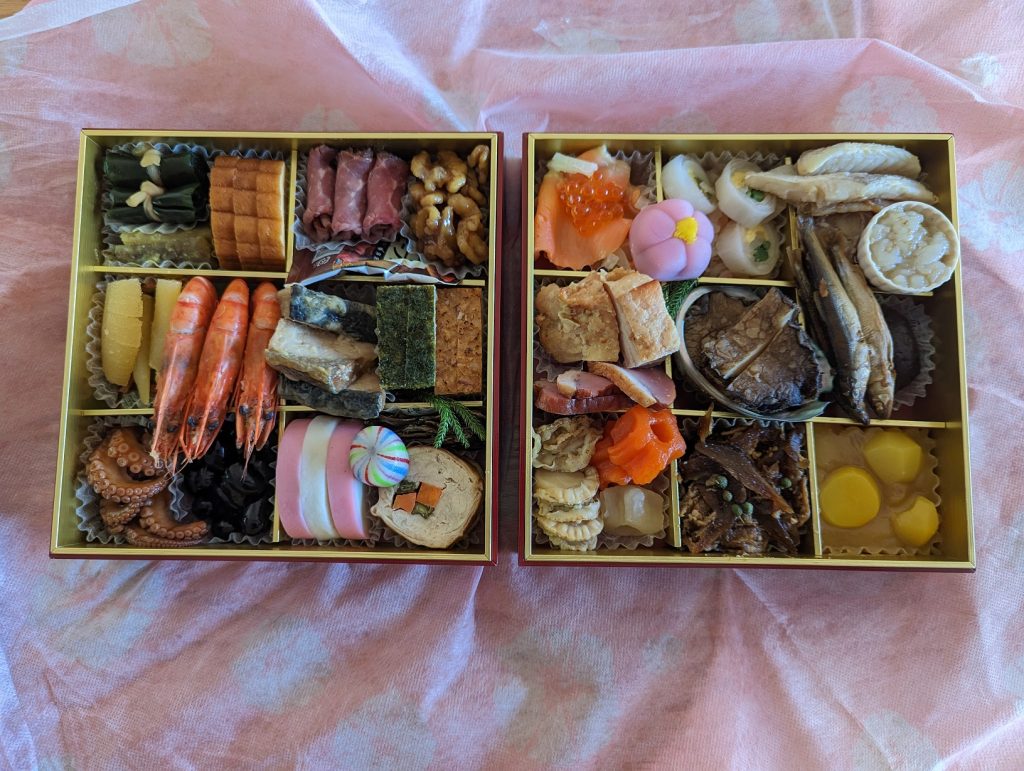
Oshina-gaki (menu)
Listed in order of number.
The first box
17 kinds of Osechi are packed!
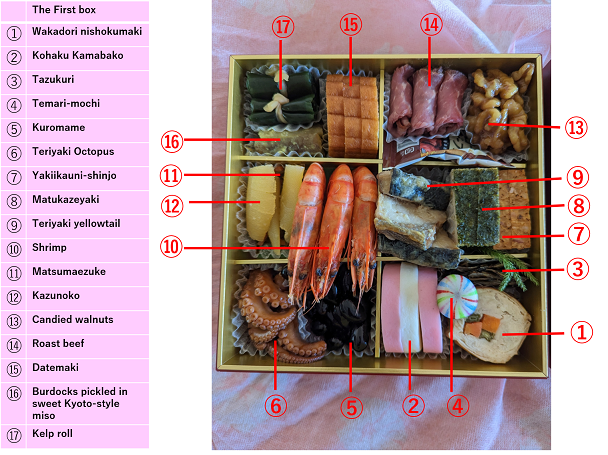
| No. | Ingredient | Description |
| ① | 若鶏二色巻 Wakadori nishokumaki | A dish of carrots and green beans wrapped in young chicken. |
| ② | 紅白かまぼこ Kohaku Kamabako | Red and white fish cake. Red means protection from evil, and white means purity. It is also said that the semi-circular shape of the dish when cut into pieces reminds people of the first sunrise of the year. |
| ③ | 田作り Tazukuri | Juvenile Japanese anchovies are dried, roasted, and tossed with sugar, soy sauce, and mirin. Celebrates a good harvest. Also called Gomame. |
| ④ | 手毬餅 Temari-mochi | Bite-sized dumplings in the shape of a temari ball. A temari ball is a small ball for traditional Japanese handball game. |
| ⑤ | 黒豆 Kuromame | Black soybeans. Soybeans signify a strong body and a wish for a healthy life. Black is also said to be the color to ward off evil and to purge one year’s misfortune. |
| ⑥ | たこの照焼 Octopus teriyaki | Teriyaki is a cooking method in which ingredients are seasoned with a sweet and spicy sauce made by combining soy sauce, sake, mirin, sugar, and other ingredients. Octopus (tako)is sometimes called “多幸(tako),” which means “many blessings,” and is also considered a lucky charm because it has eight legs, making it a “末広り(suehirogari)” in Japanese. “Suehirogari” indicates the gradual spreading of the end of a thing. |
| ⑦ | 焼いかうに新丈 Yakiikauni-shinjo | Grilled squid and sea urchin surimi, grated yam, egg white, etc., formed into a shape and steamed, boiled, or fried. |
| ⑧ | 松風焼きMatsukazeyaki | A dish baked with poppy seeds sprinkled on the surface. Since there is nothing on the back, this dish is meant to encourage people to live an honest life with nothing to hide. |
| ⑨ | 鰤照り焼 Teriyaki yellowtail | Yellowtail is a “shusseuo(出世魚)” that changes its name as it grows in Japanese. It is an ingredient often eaten to wish for success and success in life. |
| ⑩ | 海老旨煮 Shrimp | Shrimp is compared to an old man because their waist bends when they are cooked, and they are considered a symbol of longevity, living a long life until the waist bends. It is also a food for growth, development, and success in life, as it grows by repeatedly shedding its skin. |
| ⑪ | 松前漬Matsumaezuke | Preserved food made by cutting dried squid and kelp into small pieces and marinating them in soy sauce, sake, mirin, sugar, etc. |
| ⑫ | 数の子 Kazunoko | Kazunoko is herring roe. It is eaten as a good-luck charm for the prosperity of offspring because of the large number of roe. |
| ⑬ | くるみ甘露煮 Candied walnuts | Peeled walnuts boiled in sugar water. It is derived from the fact that walnuts have hard shells, and is a wish for family happiness. |
| ⑭ | ローストビーフ Roast beef | – |
| ⑮ | 伊達巻 Datemaki | This dish is made from egg and hanpen. It is a good-luck item to wish for “an increase in wisdom” because of its gorgeous appearance and its shape that resembles a scroll. |
| ⑯ | ごぼう西京漬 Burdocks pickled in sweet Kyoto-style miso | Burdocks have long, straight roots in the ground, making them an auspicious foodstuff, wishing for a firm and solid foundation for one’s home. |
| ⑰ | 昆布巻 Kelp roll | Kelp has been a good-luck food for a long time because of the word “yorokobu” (meaning “good luck”). In addition to its celebratory meaning, it is also associated with the wish for longevity. The character for “kobu” in kombu (kelp) is also said to mean “prosperity of offspring. |
The second box
There are 20 kinds of osechi in the box! All in all, there are 37 kinds of osechi.
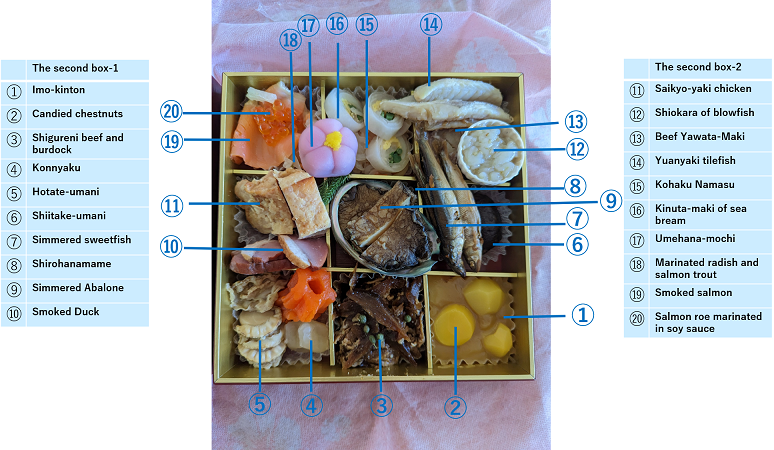
| No. | Ingredient | Description |
| ① | 芋きんとん Imo-kinton | Mashed sweet potatoes. A dish that wishes for a golden rise. |
| ② | 栗甘露煮 Candied chestnuts | Peeled chestnuts boiled down with sugar water and sweetened. A dish that wishes for a golden rise. |
| ③ | 牛肉とごぼうのしぐれ煮 Shigureni beef and burdock | Simmered beef and burdock. Shigureni is a sweet and spicy stew made with ginger in a shoyu-based broth. Burdocks have long, straight roots in the ground, which is a good omen for a solid foundation for a house. |
| ④ | 花こんにゃくKonnyaku | Red and white konnyaku in the shape of flowers. |
| ⑤ | 帆立旨煮 Hotate-umani | Scallops are stewed in a sweet and spicy seasoning. “帆立(Hotate)” means “帆を立てる(to set sail)” and is an ingredient for wishing for smooth sailing in the new year. And, the character for “shellfish” is “貝”. As it is spreading of the end of a character, and shellfish is a good omen. |
| ⑥ | 椎茸旨煮 Shiitake-umani | A stew of shiitake mushrooms seasoned with sweet and spicy sauce. Shiitake mushrooms are often cut into hexagonal shapes and used to resemble the shell of a turtle. The turtle is a symbol of longevity in Japan, and the dish is meant to wish for a long life. |
| ⑦ | 鮎の煮びたし Simmered sweetfish | Nibitashi is a way of simmering small fish suitable for eating with the bones. |
| ⑧ | 白花豆Shirohanamame | Sugar flavored white kidney beans. Beans signify a strong body and wish for a healthy life. |
| ⑨ | あわび旨煮 Simmered Abalone | Abalone is believed to be long-lived, and this dish is a good-luck charm to wish for longevity. |
| ⑩ | 合鴨スモーク Smoked Duck | – |
| ⑪ | 彩どりもも西京焼 Saikyo-yaki chicken | Saikyo-yaki is grilled meat marinated in white miso paste. |
| ⑫ | ふぐの白造り Shiokara of blowfish | Shiokara is a traditional Japanese preserved food made by fermenting the flesh of fish and shellfish, along with their guts, in salted water. |
| ⑬ | 牛肉八幡巻 Beef Yawata-Maki | Yawata-maki is a local Japanese dish consisting of burdock root and other vegetables wrapped with meat or eel. Burdocks have long, straight roots in the ground, making them an auspicious foodstuff, wishing for a firm and solid foundation for one’s home. |
| ⑭ | 甘鯛柚庵焼 Yuanyaki tilefish | A dish in which sea bream is grilled in a marinade made from soy sauce, sake, mirin, and slices of yuzu (Japanese citron). The reading of the character for “鯛” is “tai”. In Japan, the word for happy is medetai(めでたい), and since the reading “tai” is the same, 鯛(sea bream) is considered a food with good luck. |
| ⑮ | 紅白なます Kohaku Namasu | This dish is made by draining carrots and daikon radish cut into thin strips and mixing them with seasoned vinegar. The thinly sliced carrots and daikon radish are used as a mizuhiki (a red and white ribbon of good luck) to wish for peace in the family. |
| ⑯ | 鯛きぬた巻 Kinuta-maki of sea bream | Kinuta-maki is a cylindrical dish rolled into a spiral shape. It is cut into small pieces and served with vinegar.The rea ding of the character for “鯛” is “tai”. In Japan, the word for happy is medetai(めでたい), and since the reading “tai” is the same, 鯛(sea bream) is considered a food with good luck. |
| ⑰ | 梅花餅 Umehana-mochi | Dumplings in the shape of plum blossoms |
| ⑱ | 大根とサーモントラウトのマリネ Marinated radish and salmon trout | – |
| ⑲ | スモークサーモン smoked salmon | – |
| ⑳ | いくら醬油漬 Salmon roe marinated in soy sauce | Ikura is the roe of salmon or trout. The salmon roe that decorates Osechi is considered to be a lucky charm for the prosperity of offspring, along with the herring roe, as it is believed to bring good luck in the form of a wish to be blessed with children. |
My impression
When I looked into it, I found once again that it is filled with many meanings.
Incidentally, it is said that Buddhist custom forbade the eating of four-legged pigs, cows, horses, and other meat during the New Year’s holiday, but I found that they were included in the Osechi dishes this time. Customs change with the times.
It is typical Japanese to combine fine lucky charms.
I usually have fewer opportunities to eat authentic Japanese food, so I learned a lot.
Posts About Oshogatsu are bellow.
Shogatsu; New Year’s holidays in Japan
The way Japanese people view religion and my Hatsumode to Meiji Shrine

Japanese OL. (OL means “office lady”. Women who work in offices.)
I was born in a rural part of the Kanto area in the latter half of the 1980s. I live and work in Tokyo now. I live with my husband. I study English by writing this blog!

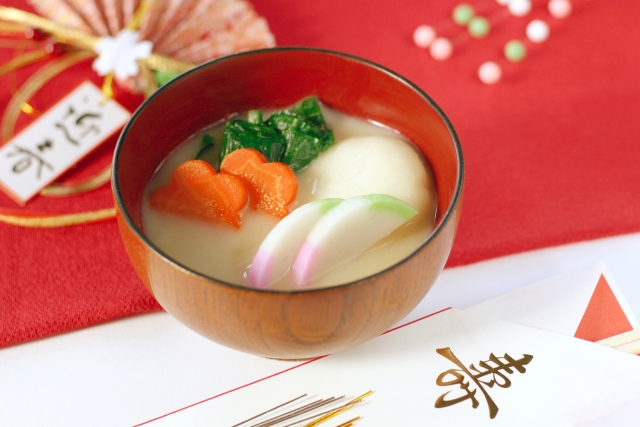

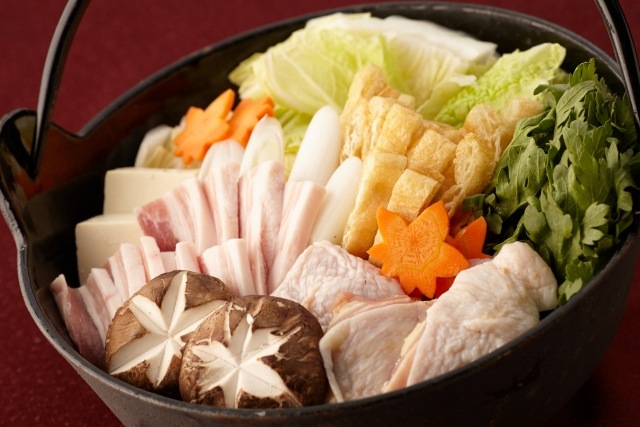






Im a forgiener living in Tokyo. Thank you so much for your blog. I learn a lot.
Thanks!